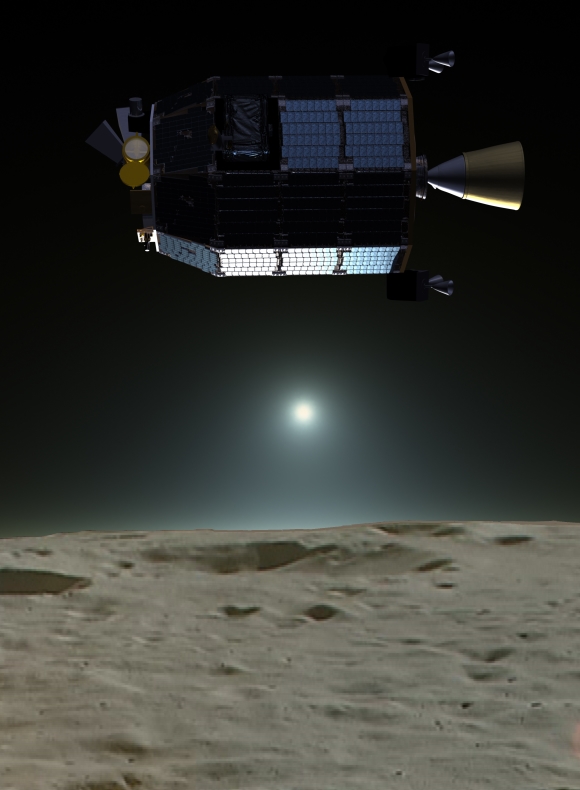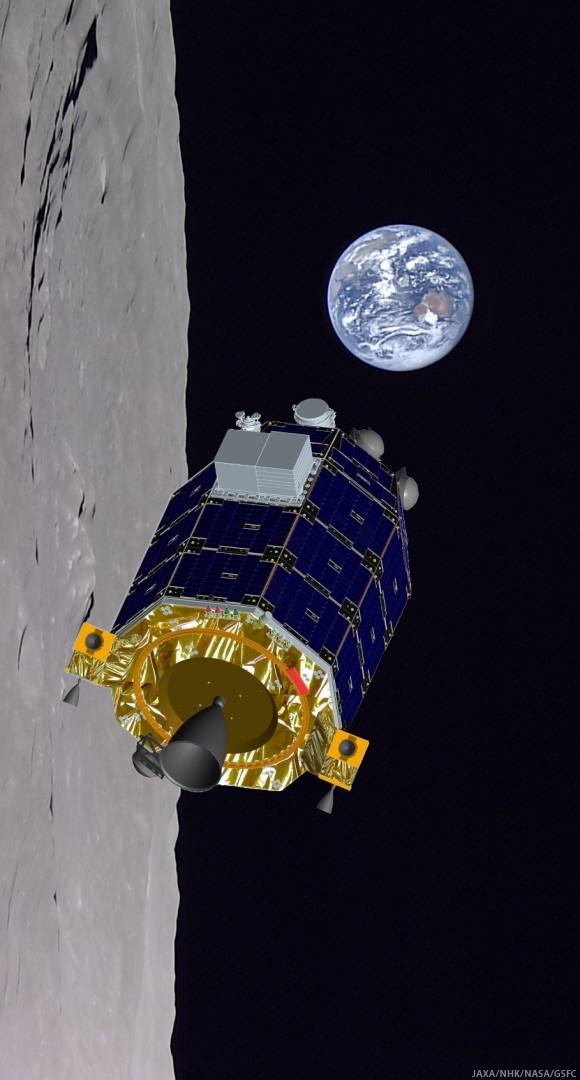Rachel Hoover
NASA Ames Research Center
NASA's Lunar Atmosphere and Dust Environment Explorer (LADEE) has been approved for a 28-day mission extension. The spacecraft is now expected to impact the lunar surface on or around April 21, 2014, depending on the final trajectory.
The extension provides an opportunity for the satellite to gather an additional full lunar cycle worth of very low-altitude data to help scientists unravel the mysteries of the moon’s atmosphere.
"The launch vehicle performance and orbit capture burns using LADEE's onboard engines were extremely accurate, so the spacecraft had significant propellant remaining to enable extra science," said Butler Hine, LADEE project manager at NASA’s Ames Research Center in Moffett Field, California, where the mission was designed, built, tested, and its day-to-day operations are managed. "This extension represents a tremendous increase in the amount of science data returned from the mission."
The small, car-sized robotic probe launched Sept. 6, 2013, from NASA's Wallops Flight Facility on Wallops Island, Virginia, and has been orbiting the moon since October 6.
On November 10, LADEE began gathering science data and on November 20, the spacecraft entered its science orbit around the moon's equator at an altitude between 12 to 60 kilometers; a unique position that allows the spacecraft to frequently pass from lunar day to lunar night, approximately every two hours. This vantage provides data about the full scope of changes and processes occurring within the moon's tenuous atmosphere.
"The science team has already established a baseline of data for the tenuous lunar atmosphere, or exosphere, and dust impacts," said Rick Elphic LADEE project scientist at Ames. "One cool thing about this extension is that we plan to fly LADEE at only a few kilometers above the lunar surface. This will be much lower than we’ve been before."
Using a set of three instruments, scientists are able to measure the chemical composition of the atmosphere, collect and analyze samples of lunar dust particles in the atmosphere and hope to address a long-standing question: Was lunar dust, electrically charged by sunlight, responsible for the pre-sunrise glow above the lunar horizon detected during several Apollo missions?
Specifically, the Neutral Mass Spectrometer (NSM) operates while pointing in different directions to look for atoms and molecules in the lunar atmosphere from a variety of sources, and has measured helium, neon, and argon-40; three noble gases. The Ultraviolet-Visible Spectrometer (UVS) has peered over the lunar horizon to look for the glow of atoms, molecules and dust in the lunar atmosphere and has made measurements of atmospheric sodium and potassium at lunar sunset, sunrise and noon. The Lunar Dust Experiment (LDEX) recorded dust impacts as soon as its cover opened and has measured the dust tossed up by a fairly steady "rain" of meteoroids on the lunar surface. LDEX occasionally sees an increase in dust impacts due to meteoroid showers, such as the Geminids, and "dust bursts" that may be due to LADEE flying through plumes kicked up from nearby meteoroid impacts.
Detailed information about the structure and composition of the thin lunar atmosphere and whether dust is being lofted into the lunar sky will help researchers understand other bodies in the solar system, such as large asteroids, Mercury and the moons of outer planets.
LADEE was built using an Ames-developed Modular Common Spacecraft Bus architecture, a general purpose spacecraft design that allows NASA to develop, assemble and test multiple modules at the same time. The LADEE bus structure is made of a lightweight carbon composite with an unfueled mass of 547.2 pounds.
NASA's Science Mission Directorate in Washington funds the LADEE mission. Ames manages the overall mission and serves as a base for mission operations and real-time control of the probe. NASA's Goddard Space Flight Center in Greenbelt, Maryland, catalogues and distributes data to a science team located across the country and manages the science instruments. NASA's Marshall Space Flight Center in Huntsville, Alabama manages LADEE within the Lunar Quest Program Office.
NASA Ames Research Center
NASA's Lunar Atmosphere and Dust Environment Explorer (LADEE) has been approved for a 28-day mission extension. The spacecraft is now expected to impact the lunar surface on or around April 21, 2014, depending on the final trajectory.
The extension provides an opportunity for the satellite to gather an additional full lunar cycle worth of very low-altitude data to help scientists unravel the mysteries of the moon’s atmosphere.
"The launch vehicle performance and orbit capture burns using LADEE's onboard engines were extremely accurate, so the spacecraft had significant propellant remaining to enable extra science," said Butler Hine, LADEE project manager at NASA’s Ames Research Center in Moffett Field, California, where the mission was designed, built, tested, and its day-to-day operations are managed. "This extension represents a tremendous increase in the amount of science data returned from the mission."
The small, car-sized robotic probe launched Sept. 6, 2013, from NASA's Wallops Flight Facility on Wallops Island, Virginia, and has been orbiting the moon since October 6.
On November 10, LADEE began gathering science data and on November 20, the spacecraft entered its science orbit around the moon's equator at an altitude between 12 to 60 kilometers; a unique position that allows the spacecraft to frequently pass from lunar day to lunar night, approximately every two hours. This vantage provides data about the full scope of changes and processes occurring within the moon's tenuous atmosphere.
"The science team has already established a baseline of data for the tenuous lunar atmosphere, or exosphere, and dust impacts," said Rick Elphic LADEE project scientist at Ames. "One cool thing about this extension is that we plan to fly LADEE at only a few kilometers above the lunar surface. This will be much lower than we’ve been before."
Using a set of three instruments, scientists are able to measure the chemical composition of the atmosphere, collect and analyze samples of lunar dust particles in the atmosphere and hope to address a long-standing question: Was lunar dust, electrically charged by sunlight, responsible for the pre-sunrise glow above the lunar horizon detected during several Apollo missions?
 |
| Relative orbital positions of LRO (red), LADEE (blue) and Chang'e-3 only minutes prior to the latter's landing in Mare Imbrium, December 14 ["Post-Landing look at Chang'e trajectory," The Astrogator's League (astrogatorsleague.com)]. |
Detailed information about the structure and composition of the thin lunar atmosphere and whether dust is being lofted into the lunar sky will help researchers understand other bodies in the solar system, such as large asteroids, Mercury and the moons of outer planets.
LADEE was built using an Ames-developed Modular Common Spacecraft Bus architecture, a general purpose spacecraft design that allows NASA to develop, assemble and test multiple modules at the same time. The LADEE bus structure is made of a lightweight carbon composite with an unfueled mass of 547.2 pounds.
NASA's Science Mission Directorate in Washington funds the LADEE mission. Ames manages the overall mission and serves as a base for mission operations and real-time control of the probe. NASA's Goddard Space Flight Center in Greenbelt, Maryland, catalogues and distributes data to a science team located across the country and manages the science instruments. NASA's Marshall Space Flight Center in Huntsville, Alabama manages LADEE within the Lunar Quest Program Office.
Related Recent Posts:
LROC captures LADEE from 9,000 meters (January 30, 2014)
Red Moon, Blue Moon Dwayne Day, The Space Review (December 3, 2013)
LADEE begins collecting data (November 22, 2013)
LADEE transitioning out of commissioning phase (November 6, 2013)
Apollo 12 ALSEP first to measure dust accumulation (November 21, 2013)
Chang'e-3 & LADEE: The Role of Serendipity (October 31, 2013)
LADEE LLCD sets new data record (October 25, 2013)
Measuring almost nothing, looking for the almost invisible (October 16, 2013)
LADEE legacies (September 7, 2013)
LROC captures LADEE from 9,000 meters (January 30, 2014)
Red Moon, Blue Moon Dwayne Day, The Space Review (December 3, 2013)
LADEE begins collecting data (November 22, 2013)
LADEE transitioning out of commissioning phase (November 6, 2013)
Apollo 12 ALSEP first to measure dust accumulation (November 21, 2013)
Chang'e-3 & LADEE: The Role of Serendipity (October 31, 2013)
LADEE LLCD sets new data record (October 25, 2013)
Measuring almost nothing, looking for the almost invisible (October 16, 2013)
LADEE legacies (September 7, 2013)



2 comments:
Great!
But I'm still waiting to see some data from LADEE!
http://www.hou.usra.edu/meetings/lpsc2014/pdf/sess201.pdf
Post a Comment